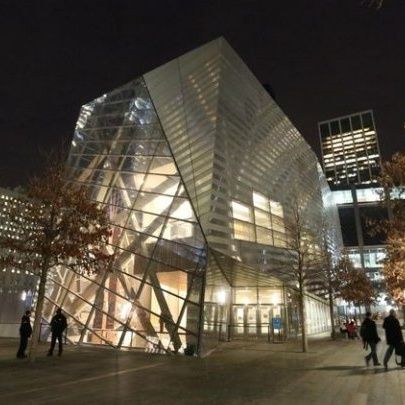The September 11th Memorial Museum Is Open

Sep 11, 2015 ·
14m 49s
"Never forget" was the heartfelt refrain after the World Trade Center attacks on September 11, 2001. And now, 13 years later, the National September 11 Memorial Museum has opened, to...
show more
"Never forget" was the heartfelt refrain after the World Trade Center attacks on September 11, 2001. And now, 13 years later, the National September 11 Memorial Museum has opened, to memorialize those who lost their lives -- and to ensure, once again, that the world will "never forget."
The museum’s power rests, first and foremost, in its location: The 110,000 square feet of exhibition space are within "the archaeological heart of the World Trade Center site." The museum takes visitors underground -- literally. It lies 70 feet below ground, so entering the museum involves descent from the light of the outside into dimly lit depths, which adds to the overall power and pathos of this hallowed ground. A variety of fascinating exhibits reveal the makeup of New York City’s impressive bedrock, like a 450-million-year-old chunk of Manhattan schist, excavated in August 2008. WTC’s architectural grandeur is also showcased via a large-scale model, originally built in 1969 to 1971, which is one of the largest and most detailed WTC presentation models still surviving today. It’s a powerful piece, because it highlights what the World Trade Center was, rather than what became of it.
And what became of the WTC is displayed throughout the museum, including the Survivors’ Staircase, which was the last visible remnant of the buildings after the attacks. The stairs served as a critical life route for many to escape, and in 2008, the 58-ton stairway moved to the museum, where it looms today. Visitors can also view a massive twisted piece of "impact steel" -- a portion of the north tower facade that suffered a direct hit from American Airlines Flight 11. One side of the museum encompasses the slurry wall, a retaining wall that was built to keep the Hudson River from flooding the site. But though the museum is filled with massive pieces that bear the scars of tragedy, it’s the small personal objects that are perhaps the most haunting: smudged reading glasses, a pair of heels, a trampled wallet splayed to reveal its contents of coins and credit cards, a flight attendant’s wing lapel. As New York Times art critic Holland Carter beautifully summed it up: “Infused with lost life, they make the experience of moving through this museum at once theatrical, voyeuristic and devotional.”
Above all, the museum is a tribute to the victims, to the survivors -- and to their loved ones. Numerous exhibits feature photographs, audio, videotapes and recorded testimonies connected to September 11, 2001 and also to the February 26, 1993, WTC bombing.
In many ways, the museum is as much about the WTC’s demise as it is about New York City’s resilience. This is especially evident above ground, at the sun-washed memorial, where parapets engraved with the 2,983 victims’ names surround the twin Memorial pools, which shimmer in the footprints of the Twin Towers. Here, beauty has taken the place of tragedy.
show less
The museum’s power rests, first and foremost, in its location: The 110,000 square feet of exhibition space are within "the archaeological heart of the World Trade Center site." The museum takes visitors underground -- literally. It lies 70 feet below ground, so entering the museum involves descent from the light of the outside into dimly lit depths, which adds to the overall power and pathos of this hallowed ground. A variety of fascinating exhibits reveal the makeup of New York City’s impressive bedrock, like a 450-million-year-old chunk of Manhattan schist, excavated in August 2008. WTC’s architectural grandeur is also showcased via a large-scale model, originally built in 1969 to 1971, which is one of the largest and most detailed WTC presentation models still surviving today. It’s a powerful piece, because it highlights what the World Trade Center was, rather than what became of it.
And what became of the WTC is displayed throughout the museum, including the Survivors’ Staircase, which was the last visible remnant of the buildings after the attacks. The stairs served as a critical life route for many to escape, and in 2008, the 58-ton stairway moved to the museum, where it looms today. Visitors can also view a massive twisted piece of "impact steel" -- a portion of the north tower facade that suffered a direct hit from American Airlines Flight 11. One side of the museum encompasses the slurry wall, a retaining wall that was built to keep the Hudson River from flooding the site. But though the museum is filled with massive pieces that bear the scars of tragedy, it’s the small personal objects that are perhaps the most haunting: smudged reading glasses, a pair of heels, a trampled wallet splayed to reveal its contents of coins and credit cards, a flight attendant’s wing lapel. As New York Times art critic Holland Carter beautifully summed it up: “Infused with lost life, they make the experience of moving through this museum at once theatrical, voyeuristic and devotional.”
Above all, the museum is a tribute to the victims, to the survivors -- and to their loved ones. Numerous exhibits feature photographs, audio, videotapes and recorded testimonies connected to September 11, 2001 and also to the February 26, 1993, WTC bombing.
In many ways, the museum is as much about the WTC’s demise as it is about New York City’s resilience. This is especially evident above ground, at the sun-washed memorial, where parapets engraved with the 2,983 victims’ names surround the twin Memorial pools, which shimmer in the footprints of the Twin Towers. Here, beauty has taken the place of tragedy.
Information
| Author | Arroe Collins |
| Website | - |
| Tags |
Copyright 2024 - Spreaker Inc. an iHeartMedia Company
